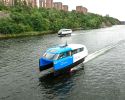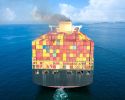The hydrogen project led to great collaboration

In shipping, there’s been a lot of talk about collaboration as the fuel of the future. The work in the pre-study Safe Hydrogen Installation on board, made within the Swedish Transport Administration's industry program Sustainable Shipping, which is run by Lighthouse, is a perfect example of this. 47 actors from all possible directions are now part of a network that takes the hydrogen issue further.
“As a researcher, you are used to a small part of the industry being interested in research projects, but here everyone, from authorities and shipowners to technology suppliers, has really been involved. The reference group we have had has been extremely committed”, says Ellinor Forsström, project manager at RISE.
Project-wise, it is an experience she will bring with her. The difference is big on how far you get with research results, depending on whether you have the industry with you or if you have to seek help with input.
“This has made the network that was intended as a "delivery on the side" one of the main results of the pre-study. We had hoped to bring in some industry partners to build a network after the pre-study ended, but it has already been established. We continue to work with seminars and events this spring.”
The aim of the pre-study was to create a "guide" for the installation of a hydrogen-powered fuel cell driveline in an existing ship - a so-called retrofit. For this, Ventrafiken's passenger and car ferry Uraniborg, which operates the Landskrona-Ven route, has been used. Based on the ship's operating profile and physical conditions, a hypothetical fuel cell/battery concept has been developed and undergone a risk identification analysis.
“In the case of Uraniborg, it is in practice possible to make a retrofit installation, but just as with all alternative fuels right now, it presupposes that a completely unique concept is developed. There are no standards, which means that an enormous responsibility is placed on the shipping company and the design company”, says Ellinor Forsström.
The conclusion is that it is easier to build new instead of rebuilding. Although Uraniborg is for some reasons perfectly suitable for a retrofit (it has a set route which means that the fuel is stored at one and the same place), the spaces on machine tires are limited in terms of how much hydrogen you can bring on board.
“Major interventions would be needed, partly to make room for the hydrogen tanks in a practical way, and partly to get it in a way that would meet the various safety aspects related to fuel handling on board. We have not looked at the economy in this study, but from an economic perspective, it probably makes more sense to invest in building a new ship in the current situation.”
But that may change soon. An international standard on how to build and install hydrogen-powered drivelines is underway.
“IMO, Bureau Veritas and others are developing guidelines on how to install fuel cells and handle hydrogen on board. There will soon be a clear turning point that makes it much easier to develop retrofit solutions.”
The pre-study has not only created a network - it will probably also lead to further research.
“There are many possible continuation projects that we see as current. On the one hand, we want to dig deeper into the bunkering procedure. This is a very interesting issue, both technically and in terms of safety”, says Ellinor Forsström.
Footnote. The study was conducted by Andreas Bach, Stina Andersson, Ellinor Forsström (RISE, Research Institutes of Sweden), Karl Jivén, Helena Lundström (IVL Swedish Environmental Research Institute) and Nicklas Blidberg (CLOSER / Lindholmen Science Park)
-
 NextWave – en podd som ska locka unga
NextWave – en podd som ska locka unga -
 Ny studie: Eldrivna pendelbåtar kan effektivisera Stockholms kollektivtrafik
Ny studie: Eldrivna pendelbåtar kan effektivisera Stockholms kollektivtrafik -
 Sjöfartens utsläpp ökar
Sjöfartens utsläpp ökar -
 Sociala relationer påverkar val av bränsle
Sociala relationer påverkar val av bränsle -
 Sjöfartens omställning kräver ”mjukare” påtryckningar
Sjöfartens omställning kräver ”mjukare” påtryckningar -
 Hon hade avtalad tid med Kapten ynkrygg
Hon hade avtalad tid med Kapten ynkrygg -
 Lighthouse omvärldsanalys 2025 – osäkerhet och tullar präglar sjöfarten
Lighthouse omvärldsanalys 2025 – osäkerhet och tullar präglar sjöfarten -
 Se seminariet Shipping in the Marine Environment
Se seminariet Shipping in the Marine Environment -
 Vad betyder egentligen de 90 procenten?
Vad betyder egentligen de 90 procenten? -
 Hålla där...
Hålla där...

